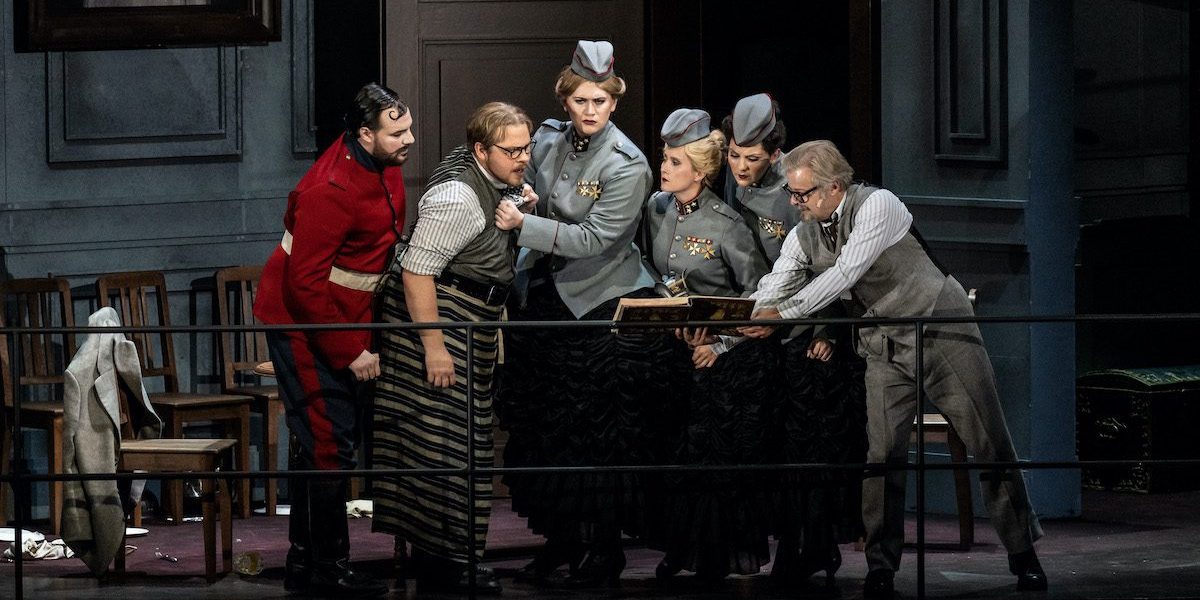For the 2022 Summer Festival, the American stage director Lydia Steier has reworked her 2018 production of Mozart’s Die Zauberflöte collaborating with the acclaimed conductor Joana Mallwitz.
According to Steier’s central idea, this opera starts as a fairy tale in the first act and eventually intertwines with some serious content in the second act. Following this pattern, the prologue opens with a stage showing a doll house of an upper-class family. After a quarrel between husband and wife their three children are sent to bed and told the story of Tamino and Pamina by their grandfather. Subsequently, these characters become Sarastro, the Queen of the Night, and the three boys accompanying Tamino and Papageno in their quest for Pamina. The grandfather Roland Koch is the narrator. This expedient works well because instead of the stilted dialogues of the original singspiel by Emanuel Schikaneder we get a dynamic interaction between narrator and orchestra.
The stage designer Katharina Schlipf contributes to a highly entertaining show – there are special effects, projections, and a well-crafted revolving stage. Even the desires of the all too earthy Papageno get a graphic representation with giant fruits, cakes, and butterfly girls.
Steier makes Pamina the pivotal point of the action as she evolves from a scared kidnapped girl controlled by an oppressive mother to a self-assured woman. However, the other characters don’t receive the same care: Tamino appears to suffer the events rather than leading the action, and the Queen of the Night resembles a desperate housewife rather than a fearful tyrant, scheming and manipulating to protect her crumbling power. The high priest Sarastro resembles a ruthless businessman in his bowler hat who uses his influence to recruit new affiliates for his wars rather than pursuing higher ideals. This is overtly suggested by the military action on stage and gruesome images of the First World War projected onto the stage in the second act.
Overall, we see lots of original ideas in this production. However, they don’t resolve in a coherent plot rather they collide, creating a kaleidoscope where the spectator loses sight of Mozart’s common thread. The allegorical journey from the darkness and the lies, personified by the Queen of the Night, to the truth of the Enlightenment ideals, represented by Sarastro, that can be completed through pure love, discipline, and the power of music, here disappears under an orgy of colours and teddy bears.
The lack of clarity in the staging is not compensated for by the cast: Brenda Rae in the role of Queen of the Night doesn’t thrill the audience, she lacks the fierceness and vocal strength required by the role and she wobbles on the top notes. Mauro Peter as Tamino gives a disjointed performance, whereas Tareq Nazmi as Sarastro lacks charisma and persuasiveness and vocally he is not a Mozartian basso profundo. It gets better with Michael Nagl’s convincing, witty and energetic interpretation of Papageno, Peter Tantsits’ Monostatos, and the three ladies, Ilse Eerens, Sophie Rennert, and Noa Beinart. Kudos to the three boys from Vienna Boys Choir. Regula Mühlemann in the role of Pamina is the highlight of the evening, with her vocal control and intensity she is able to convey pure emotion to the audience.
Huge praise goes to the orchestra and Mallwitz who is imposing herself as a leading Mozartian interpreter. She is fast to respond and adapt to the stage dynamics, although the overture with its fast tempi seems a bit rushed.
Overall, this performance is an interesting reading of Mozart’s masterpiece, but it is not a hit.

